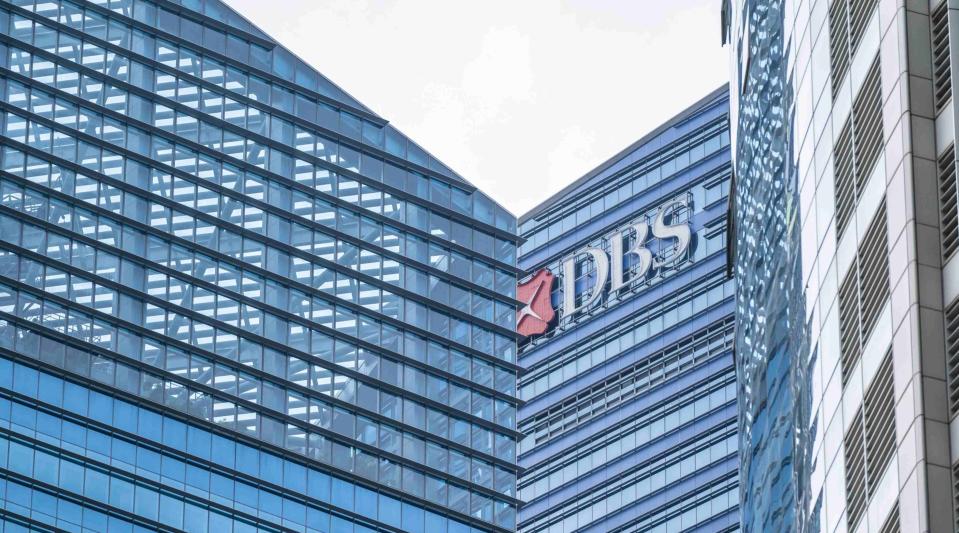DBS wins praise from analysts for 'massive' NIM expansion, but rising rates threaten cost of funds

With the slower loan growth outlook, there is “significant room” to raise dividends in 4QFY2022, says one analyst.
DBS Group Holdings’ “massive” net interest margin (NIM) expansion and “improved” asset quality for the latest quarter has won praise from analysts, though continued increase in US Fed interest rates spell higher cost of funds as customers reposition to fixed deposits.
Last week, DBS posted record high earnings of $2.24 billion for 3QFY2022 ended September, up 32% y-o-y and 23% q-o-q.
UOB Kay Hian Research analyst Jonathan Koh has the highest target price on DBS among research houses here. In a Nov 4 note, Koh is maintaining “buy” with a lower target price of $45 from $45.75 previously. The new target price represents a 31,6% upside against a share price of $34.20.
Koh points to DBS’s “toned down guidance” for NIM expansion at higher interest rates. “Management had previously guided that every 1 basis point (bp) increase in Fed Funds Rate would boost net interest income by $18 million to $20 million per year. This modelling was conducted assuming that the Fed Funds Rate rises to 4%. At higher levels of interest rates, customers start to reposition from current account savings account (CASA) to fixed deposits, which results in higher cost of funds.”
Thus, DBS has halved its estimated sensitivity to $9 million to $10 million per year when the Fed Funds Rate is above 4%.
For 3QFY2022, DBS’s return on equity (ROE) reached a new high of 16.3%. Looking ahead, Koh notes a lack of visibility, but credit cost is budgeted to normalise higher to 20 bps, while ROE is projected to be “comfortably above 15%”.
DBS’s guidance for FY2023 forecasts loan growth at mid-single digit, as its loan pipeline remains healthy, writes Koh. “There could be moderation for US dollar-denominated loans as Chinese corporate customers switch to borrowing at lower cost in their onshore market in mainland China.”
NIM is expected to reach 2.25% by mid-2023 assuming that the Fed Funds Rate peaks at 4.75%, notes Koh. Fee income is expected to grow at a double-digit rate, led by wealth management and cards, while DBS’s cost-to-income ratio is likely to fall below 40%.
Citi Research analysts Tian Yafei and Tan Yong Hong are keeping a close watch on DBS’s cost growth, which grew 10% q-o-q and 9% y-o-y due to higher staff expenses.
Other expenses, meanwhile, rose “more moderately” at 8% q-o-q and y-o-y, write Tian and Tan in a Nov 3 note.
DBS’s cost-to-income ratio improved 3.5 percentage points (ppt) y-o-y to 40.2%. DBS’s expenses grew 7% to $5.13 billion, and profit before allowances rose 12% to $6.96 billion.
Credit Suisse, meanwhile, highlighted lower CASA, which fell by 8.37% q-o-q to $350 million amid customers’ repositioning of funds. The CASA ratio deteriorated by 6.6 ppt q-o-q to 65.7%, while fixed deposits correspondingly expanded $37 billion q-o-q as domestic interest rates surged in tandem with the higher Fed Funds Rate.
Potentially higher dividends
Meanwhile, Maybank Research analyst Thilan Wickramasinghe sees “potentially higher dividends” from DBS’s “strong franchise”, raising his target price to $42.69 from $42.18 while maintaining “buy” on the bank.
For 3QFY2022, DBS declared a quarterly dividend of 36 cents per share. This brings its total dividend for the 9MFY2022 to $1.08 per share.
“The group’s strong franchise, execution track record and balance sheet should still deliver ROEs above 15% in 2023 — a historical high. This should catalyse higher dividends going forward,” writes Wickramasinghe in a Nov 3 note.
As at Sept 30, DBS’s common equity tier-1 (CET1) ratio fell by 0.4 ppt q-o-q to 13.8% due to loan growth and the marked-to-market impact on fair value through other comprehensive income (FVOCI) securities. The leverage ratio of 6.1% was twice the regulatory minimum of 3%.
DBS’s provisioning and CET1 levels are strong, says Wickramasinghe, and with the slower loan growth outlook, there is “significant room” to raise dividends in 4QFY2022. “We have raised 2022-2024F earnings per share (EPS) by 6%-11% following 3QFY2022 adjustments.”
DBS staying prudent
RHB Group Research analysts praise DBS for staying prudent despite seeing strong asset quality. “Upgrades and recoveries led to a 5% q-o-q fall in non-performing assets (NPA) while non-performing loan (NPL) ratio improved to 1.2% [from 1.27% in the previous quarter].”
Although not seeing any stress in its portfolio, DBS has prudently topped up its general provision (GP) overlays that lifted NPA coverage to 120%, say RHB analysts. “Management conservatively guides for specific provision (SP) credit cost to normalise to 20 bps in FY2023F from the 10 bps-11 bps in FY2022F.
For these reasons, RHB is staying “buy” on DBS with a higher target price of $41.10 from $37.60 previously.
As at 10.28am, shares in DBS are trading 16 cents lower, or 0.46% down, at $34.31.
See Also:
Click here to stay updated with the Latest Business & Investment News in Singapore
Brokers' Digest: KORE, SIA, CDLHT, Netlink NBN Trust, Digital Core REIT
Citi downgrades Nanofilm to 'sell' as it sees a 'challenging path ahead' for the group
Analysts mixed on Netlink after its 1HFY2023 revenue beats consensus' estimates
Get in-depth insights from our expert contributors, and dive into financial and economic trends

 Yahoo Finance
Yahoo Finance 